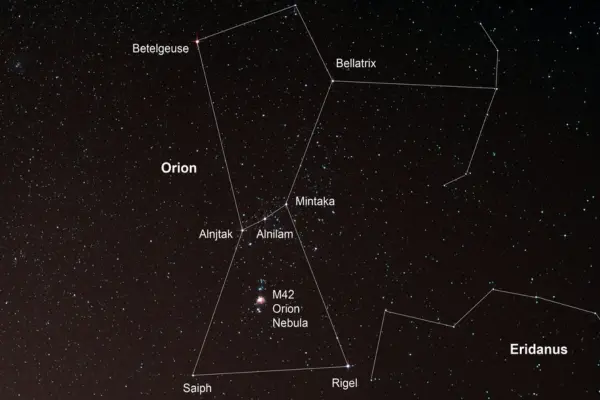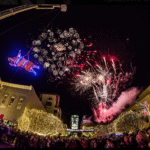Orion Constellation: Myths Behind Orion’s Belt and More!

The Orion constellation conjures deep imagination and wonder with just one glance. Something about the placement of the Orion stars ties the entire picture together. Almost every culture in the ancient world associated these stars with a hunter, a giant, or an all-around he-man. His origin story in the Greek myths is murky at best and no storyteller can seem to agree as to where he came from or how he got to be so tough. Orion typically appears in tales that require a hunter, and in these stories he proves himself to be the best around. Learn all about Orion, including how to locate the Orion stars, including Orion’s belt, in the winter night sky.

Orion Stars Mythology
In Greek mythology, Orion was pictured in the sky as a mighty hunter holding an up-raised sword to the left and either a lion’s pelt, a bow, or a shield to the right. In one legend, Orion pursued the love of the Pleiades or the Seven Sisters which wanted none of his advances. The Pleiades, so bothered by this man, asked the gods for help. To escape Orion, the gods turned the Pleiades into doves and allowed them to fly into the sky forever where they turned into the little cluster of stars visible every winter night.
Orion was a tremendous boaster which angered some of the gods. They thought it would be ironic for a tiny creature to slay the great hunter so they sent a scorpion, Scorpius, which dealt Orion a fatal bite on his heel.
For his greatness, the gods placed Orion in the sky and near the Pleiades. He continues to chase the Seven Sisters every night but an ever-vigilant bull, the constellation Taurus, blocks his path.
Alnitak, Alnilam, and Mintaka
To find Orion simply look for three stars of average brightness that form a tight line in the winter skies. Locate them and you have found Orion’s Belt. There is no other star pattern visible to the naked eye quite like it.
The three stars in Orion’s Belt are Alnitak, Alnilam, and Mintaka (from left to right). These stellar titles originated with astronomers in the Middle East and North Africa more than 1,000 years ago. Alnitak means, “the girdle,” Alnilam is, “the string of pearls,” and Mintaka simply means, “belt.”

Orion’s Belt had its own myths around the world: In Greenland it was Three Seal Hunters Lost at Sea; Eskimos called it Three Steps Cut in a Snowbank; to Australians these stars were Three Men Dancing; and in Africa it was Three Pigs.
The belt stars only look like they are closely lined up from our perspective. However, they are all incredible distances from us and one another. Alnitak is about 1,260 light years from Earth, Alnilam is the farthest of the three at 2,000 light years, and Mintaka is around 1,200 light years distant.
Orion Stars
Although the three stars in Orion’s Belt might attract your attention, three other stars also shine brightly. Rigel is Orion’s brightest star and marks the hunter’s left foot. At about 860 light years from Earth Rigel is incredibly distant, yet it is still one of the brightest stars in the night sky. In fact, Rigel is one of the most luminous stars in our part of the galaxy. Rigel shines with a blue-white light indicating that it is also a very hot star with a surface temperature of about 21,000 F.
Located above the belt stars is Orion’s second brightest star, Betelgeuse. The name of this star is translated from various Arabic titles as “armpit of the central one.” Betelgeuse is a red supergiant star, and to the naked eye it appears more orange than other stars. Betelgeuse is about 640 light-years from Earth and it is also humongous. If Betelgeuse were our Sun, its volume would stretch beyond the orbit of Jupiter. That means the Earth would orbit inside it.
Bellatrix is the blue star marking Orion’s other shoulder. Its name comes from ancient Greek and Roman and it means either “beautiful warrior woman” or “amazon star.” Legends say that any woman born under Bellatrix would be lucky in life. More specifically this star was linked to Amazon women who were strong, well-spoken, assertive, and tough. Bellatrix is about 250 light years away and has one of the deepest blue colors of any bright star with a surface temperature of about 40,000 F.
Finding Orion Every Year
You can easily identify Orion every evening between January and April. When he rises in the east-southeast in January, he will seem a little unbalanced. He looks like he is tipped over on his side and the belt stars will be like a vertical line pointing straight down to the horizon. As he reaches his highest point in the southern sky after dark in February, Orion rights himself. Standing about halfway up in the southern sky, the outline of Orion’s stars are so dramatic that he looks to be perched over the Earth and commanding the heavens.
As we get into March, Orion sets in the west-southwest, and he once again seems to tip over just before he sets below the horizon. Once April turns to May, Orion is no longer visible in the evening sky. But by fall you can see his trademark belt of three stars in the morning sky, rising in the east just before sunrise.
3 Deep Space Objects in Orion
1) Orion Nebula
Hanging from the center star of Orion’s Belt are three “stars” that form a small sword. The middle of these three is not a star at all and appears to be a little fuzzy. This is the Orion Nebula, or M42, a huge mass of gas and dust 24 light-years wide that is an active stellar nursery.
When you zoom in with a telescope you can see the Orion Nebula is illuminated by several large stars in its center. The four brightest stars make a distinct diamond pattern and are called the Trapezium. At 1,344 light years away, the Orion Nebula is the closest large star-forming region with enough material to create about 2,000 suns.

2) Barnard’s Loop
A ghostly arc of gas that appears to encircle Orion’s waist is called Barnard’s Loop. Stretching about 150 light years in space and residing about 1,600 light years from Earth, astronomers believe this formation may be the result of a massive supernova explosion and is now lit by the stars forming in the Orion Nebula. Barnard’s Loop cannot be seen with the naked eye but only appears through long exposure photography.
RELATED: How to See the Pinwheel Supernova
3) Horsehead Nebula
One of the most famous images in our galaxy is the Horsehead Nebula which lies just below Orion’s Belt star Alnitak. View an image of the Horsehead Nebula via Wikimedia Commons. The head shape is a silhouette made of dark material that blocks out the light of the more distant colorful gasses.
The pink clouds behind the formation are ionized hydrogen gasses that most likely come from Sigma Orionis, a small open cluster of stars. Although photographs make the Horsehead Nebula look stunning, at about 1,375 light years away, the picturesque image can only be seen through long exposure photography.
RELATED: Astronomy Glossary of Terms
Any questions? Contact [email protected]
More About Orion
If you are fascinated by Orion and would like to learn more, we recommend picking up Dean’s book, All About Orion (large print with braille and tactile constellations).
Join The Discussion
Have you ever seen Orion’s Belt in the night sky?
What is one of your favorite constellations or stars?
Share with your community here in the comments below!













